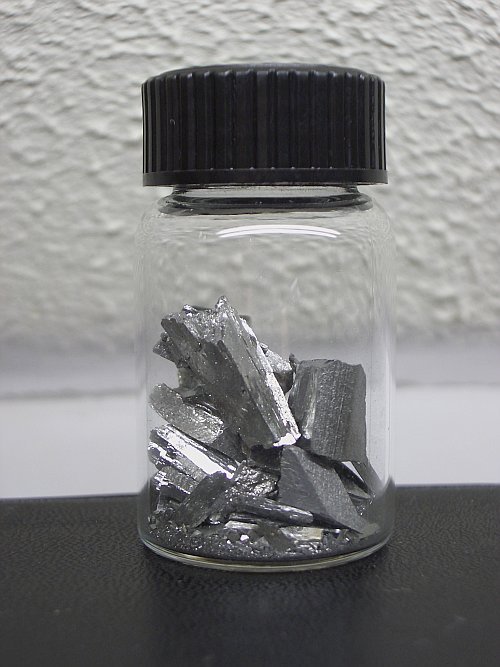


Tellurium
 Tellurium is a crystalline solid, with a remarkable
silvery metallic lustre. Although the element looks like a metal, it certainly
is not a metal. It only vaguely has metallic properties.
Tellurium is a crystalline solid, with a remarkable
silvery metallic lustre. Although the element looks like a metal, it certainly
is not a metal. It only vaguely has metallic properties.
The element has some metallic properties, but only very weakly. When tellurium is brought in contact with dilute hydrochloric acid in intimate contact with air, then it dissolves, forming a small amount of tellurium (IV) ions. These, however readily hydrolyse to hydrous tellurium dioxide.
Tellurium is quite resistant to oxidation, but aqueous solutions of tellurium compounds can be obtained by adding finely ground tellurium to a solution of chloric acid (e.g. sodium chlorate dissolved in dilute sulphuric acid or dilute nitric acid). Another oxidizer, capable of dissolving tellurium is potassium permanganate, dissolved in dilute nitric acid. The compound formed is orthotelluric acid, H6TeO6.
Elementary tellurium is available on eBay from various sellers, who sell the element in the form of chunks, ranging from a few 100 mg to over 100 grams. The element is quite expensive, its price is slightly less than $1 per gram, when purchased in 50+ gram quantities. Tellurium is not a compound to start with in a home lab. Handling tellurium compounds certainly is not without risk (see below) and the tellurium-chemistry, which can be studied by the home chemist with basic equipment only, is very limited.
![]()
In its compounds, tellurium can have oxidation states -2, +4 and +6. The -2 oxidation state is in the form of tellurides. Tellurides can be prepared by direct reaction between a finely powdered metal and finely powdered tellurium. The higher oxidation states are available by dissolving tellurium in a strongly oxidizing acid mixture (see above). No compounds of tellurium are available to the general public.

